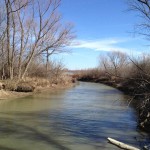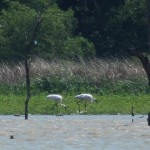This past summer we had some very special guests in North Texas. As many of you know, two groups of Whooping Cranes from White Lake in Louisiana spent the season’s warm months in and around the Dallas/Fort Worth area.
White Lake is the location of a reintroduction effort designed to reestablish a nonmigratory population Whooping Cranes along the Louisiana coast. The idea is to create a buffer population in order to protect the endangered species against natural disasters and other catastrophes.
The two groups young whoopers had other ideas and they hit the road.
The first cranes to arrive in DFW took up Lake Ray Hubbard. A male and a female who spent their time foraging up and down an isolated stretch of lake shore. These two soon became known as “The Lake Ray Hubbard Pair.” They spent several weeks at Lake Ray Hubbard before the wanderlust struck them again and they headed off to the northeast.
You can read the posts that follow their exploits by starting here: Whooping Crane – The Lake Ray Hubbard


In the meanwhile, a second group of Whooping Cranes consisting of five birds entered Texas and made their way to the metroplex following a route that took them through the small town of Fenton. They paused there long enough to pick up the nickname “The Fenton Five”.


When these five whoopers finally arrived in the DFW area they found Lewisville Lake to their liking, and soon established a routine of foraging alternatively by the lake shore and at other times far out on the dried floodplain.
This is where the Lake Ray Hubbard Pair reenter the story. After a brief stay in Wise County, the Lake Ray Hubbard whoopers somehow linked up with The Fenton Five already at Lewisville Lake, making for a grand total of seven Louisiana Whooping Cranes in Denton County.
You can read the details of this story here: Whooping Crane – The Summer of the Cranes

This arrangement lasted for several more weeks before the two groups of birds had a falling out. The Fenton Five bugged out and did not stop again until they were several counties to the southeast. The Lake Ray Hubbard Pair—with the exception of a few excursions—stayed put for the rest of the summer.
Until last Sunday (Oct 20, 2013), that is. Reports of an unexpected pair of Whooping Cranes sighted in Lufkin, Texas reached my email box by that afternoon. It was The Lake Ray Hubbard Pair! The cranes only stayed in Lufkin for one night before moving on again.
I am now happy to report that the Lake Ray Hubbard Pair have made their way safely back home to White Lake in Louisiana!
The Fenton Five are holding steady in North Texas for the time being!







My husband, Joe and I, enjoyed watching the Lake Ray Hubbard pair for several weeks. Nice story about this summer of Whooping Cranes. Met this past weekend at Texas Master Naturalists Annual Meeting and enjoyed all the stories. Your photos are beautiful. Thanks for sharing.
This was special stuff, Pam! I’m glad you were able to see the cranes in person!
Awesome DFW crane update, thank you very much! That was one of the most exciting sightings for me this year when I got to see the Whooping Cranes by Lake Ray Hubbard. Magnificent birds. Hope that their population can increase despite drought problems and “human obstacles”.
I like their chances, Annika. They have got a lot of good people in their corner!
This flock it seems is destined to find the wild cranes in Texas and who knows what could happen? Imagine a time when there were many northern destinations and birds intermixed along the whole gulf. Genetic diversity would have been enhanced in all flocks. Eventually too, the Louisiana flock will interact with the Wisconsin. Then, what about a Western Flock??? As a boy, I remember waiting to see if 20 birds had become 22, Amazing! Then we should investigate cloning the cranes in museum collections to bring back diversity from the past.
There were some concerns that these cranes would take up with the Texas birds. There were also some people would felt like that wouldn’t have been such a bad thing. In the end, all of these cranes made their way back to Louisiana. I’m no expert on Whooping Cranes, so I have no idea what the best scenario for the birds would be. All I know is that it was a great privilege to get to observe these birds, and it is very exciting to follow the progress being made in bringing them back from the brink.